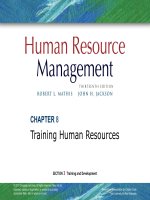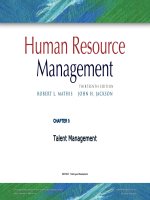Managing human resrouce management 5th by snel chapter 13
Bạn đang xem bản rút gọn của tài liệu. Xem và tải ngay bản đầy đủ của tài liệu tại đây (423.73 KB, 38 trang )
Employee Rights
and Discipline
Managing Human Resources
Belcourt * Bohlander * Snell
Copyright © 2008 by Nelson, a division of Thomson
Canada Limited.
All rights reserved.
5th Canadian edition
PowerPoint Presentation by
Monica Belcourt, York University and
Charlie Cook, The University of West Alabama
Objectives
After studying this chapter, you should be able to:
1. Explain statutory rights, contractual rights
and due process.
2. Identify the job expectancy rights of
employees.
3. Identify and explain the privacy rights of
employees.
4. Explain the process of establishing
disciplinary policies, including the proper
implementation of organizational rules.
Copyright © 2008 by Nelson, a
13–2
Objectives
(cont’d)
After studying this chapter, you should be able to:
5. Discuss the meaning of discipline and how to
investigate a disciplinary problem.
6. Differentiate between the two approaches to
disciplinary action.
7. Identify the different types of alternative
dispute resolution procedures.
8. Discuss the role of ethics in the management
of human resources.
Copyright © 2008 by Nelson, a
13–3
Employee Rights and Privacy
• Employee Rights
Guarantees fair treatment from employers, particularly
regarding an employee’s right to privacy.
Psychological contract—expectations of a fair
exchange of employment obligations between an
employee and employer
Copyright © 2008 by Nelson, a
13–4
Employment Protection Rights
• Statutory rights
Rights that derive from legislation
• Contractual rights
Rights that derive from contracts
• Due process
Employee rights to present his or her position during
a disciplinary action
Copyright © 2008 by Nelson, a
13–5
Wrongful Dismissal for Just Cause
• The employer must
document and prove
serious misconduct or
incompetence on the part
of the employee
Copyright © 2008 by Nelson, a
13–6
Tips to Avoid Wrongful Employment Termination Lawsuits
• Terminate an employee only if there is an
articulated reason.
• Set and follow termination rules and
schedules.
• Document all performance problems.
• Be consistent with employees in similar
situations.
Figure 13.1
Copyright © 2008 by Nelson, a
13–7
Constructive Dismissal
• Changing an employee’s
working conditions such
that compensation, status
or prestige is reduced.
Copyright © 2008 by Nelson, a
13–8
Job Expectancy Rights
• Employees expect certain rights associated with
fair and equitable employment, including:
Privacy
Substance abuse and drug testing
Just cause disciplinary and discharge procedures
Copyright © 2008 by Nelson, a
13–9
Privacy Rights
Employee
Employee
Privacy
Privacy
versus
versus
Employer
Employer
Obligations
Obligations
•• Substance
SubstanceAbuse
Abuseand
andDrug
Drug
Testing
Testing
•• Searches
Searchesand
andElectronic
Electronic
Monitoring
Monitoring
•• Access
Accessto
toPersonnel
PersonnelFiles
Files
E-mailand
andVoice
VoiceMail
•• Access
Accessto
toPersonal
PersonalFiles
Files
•• Conduct
ConductOutside
Outsidethe
the
Workplace
Workplace
•• Genetic
GeneticTesting
Testing
Copyright © 2008 by Nelson, a
13–10
Employee Searches and Electronic
Monitoring
1.
The search policy should be widely publicized and should
advocate a probable or compelling reason for the search.
2.
The search policy should be applied in a reasonable,
evenhanded manner.
3.
Where possible, searches should be conducted in private.
4.
The employer should attempt to obtain the employee’s
consent prior to the search.
5.
The search should be conducted in a humane and discreet
manner to avoid infliction of emotional distress.
6.
The penalty for refusing to consent to a search should be
specified.
Copyright © 2008 by Nelson, a
13–11
E-Mail, Internet, and Voice Mail: Policy Guidelines
• Ensure compliance with federal and provincial legislation.
• Specify the circumstances, if any, under which the system
can be used for personal business.
• Specify that confidential information not be sent on the
network.
• Set forth the conditions under which monitoring will be done
—by whom, how frequently, and with what notification to
employees.
• Specify that e-mail and voice mail information be sent only to
users who need it for business purposes.
• Expressly prohibit use of e-mail or voice mail to harass
others or to send anonymous messages.
• Make clear that employees have no privacy rights in any
material delivered or received through e-mail or voice mail.
• Specify that employees who violate the policy are subject to
Figure 13.2
discipline, including dismissal.
Copyright © 2008 by Nelson, a
13–12
Personnel Files: Policy Guidelines
• Ensure compliance with applicable laws.
• Define exactly what information is to be kept in employee
files.
• Develop different categories of personnel information,
depending on legal requirements and organizational needs.
• Specify where, when, how, and under what circumstances
employees may review or copy their files.
• Identify company individuals allowed to view personnel
files.
• Prohibit the collection of information that could be viewed
as discriminatory or could form the basis for an invasion-ofprivacy suit.
• Audit employment records on a regular basis to remove
irrelevant, outdated, or inaccurate information.
Copyright © 2008 by Nelson, a
Figure 13.4
13–13
Employee Privacy Issues
• Camera-Equipped Phones
Generally banned from the workplace
• Employee Conduct outside the Workplace
Organizations that want to discipline employees for
off-duty misconduct must establish a clear
relationship between the misconduct and its negative
effect on other employees or the organization.
• Genetic Testing
Copyright © 2008 by Nelson, a
13–14
A Disciplinary Model
Organization
Organization
discipline
discipline
policy
policy
Definition
Definitionof
of
discipline
discipline
Violation
Violationof
of
organizational
organizational
rules
rules
Investigation
Investigation
of
ofemployee
employee
offence
offence
Disciplinary
Disciplinary
interview
interview
Progressive
Progressive
discipline
discipline
Due
Dueprocess
process
Just
Justcause
cause
Discharge
Discharge
Figure 13.5
Copyright © 2008 by Nelson, a
13–15
Common Disciplinary Problems
ATTENDANCE PROBLEMS
• Unexcused absence
ON-THE-JOB BEHAVIOUR PROBLEMS
• Intoxication at work
• Chronic absenteeism
• Unexcused/excessive tardiness
• Insubordination
• Horseplay
• Leaving without permission
• Smoking in unauthorized places
• Fighting
DISHONESTY AND RELATED PROBLEMS
• Theft
• Falsifying employment application
• Willfully damaging organizational
property
• Punching another employee’s time card
• Falsifying work records
WORK PERFORMANCE PROBLEMS
• Failure to complete work assignments
• Producing substandard products or
services
• Failure to meet established production
requirements
• Gambling
• Failure to use safety devices
• Failure to report injuries
• Carelessness
• Sleeping on the job
• Using abusive or threatening
language with supervisors
• Possession of narcotics or alcohol
• Possession of firearms or other
weapons
• Sexual harassment
Figure 13.6
Copyright © 2008 by Nelson, a
13–16
The Results of Inaction
• Reasons given by supervisors for their failure to impose
a disciplinary penalty:
1. The supervisor had failed to document earlier actions, so
no record existed on which to base subsequent
disciplinary action.
2. Supervisors believed they would receive little or no
support from higher management for the disciplinary
action.
3. The supervisor was uncertain of the facts underlying the
situation requiring disciplinary action.
4. Failure by the supervisor to discipline employees in the
past for a certain infraction caused the supervisor to forgo
current disciplinary action in order to appear consistent.
5. The supervisor wanted to be seen as a likable person.
Copyright © 2008 by Nelson, a
13–17
Setting Organizational Rules
Publish Widely
Review Regularly
Explain Reasons
Guidelines
for the
Implementatio
n
of
Organizational
Rules
Keep in Writing
Be Reasonable
Remind/Restate
Get Signed Statements
of Understanding
Copyright © 2008 by Nelson, a
13–18
The Hot-Stove Approach to Rule
Enforcement
• Hot-Stove Rule
Rule of discipline that can be
compared with a hot stove in
that it gives warning, is
effective immediately, is
enforced consistently, and
applies to all employees in
an impersonal and unbiased
way.
Copyright © 2008 by Nelson, a
13–19
Discipline
• Definitions of Discipline
Treatment that punishes.
Orderly behaviour in an organizational setting.
Training that molds and strengthens desirable
conduct or corrects undesirable conduct and
develops self-control.
Copyright © 2008 by Nelson, a
13–20
Considerations in Disciplinary Investigations
1. In very specific terms, what is the offence charged?
2. Did the employee know he or she was doing
something wrong?
3. Is the employee guilty?
4. Are there extenuating circumstances?
5. Has the rule been uniformly enforced?
6. Is the offence related to the workplace?
7. What is the employee’s past work record?
Figure 13.7
Copyright © 2008 by Nelson, a
13–21
Documentation of Employee
Misconduct
• Date, time, and location of the incident(s)
• Description of the problem/misconduct
• Consequences of misconduct on employee and/or work
unit
• Prior discussions with employee about conduct
• Disciplinary action to be taken and specific improvement
expected
• Consequences for employee if behaviour is not changed
and follow-up date
• Reaction of employee to supervisor’s efforts
• Names of witnesses to incident
Copyright © 2008 by Nelson, a
13–22
The Investigative Interview
• Conduct of an Interview
Concentrate on how the offence violated the
performance and behavior standards of the job.
Avoid getting into personalities or areas unrelated to
job performance.
Give the employee must be given a full opportunity to
explain his or her side of the issue.
Copyright © 2008 by Nelson, a
13–23
Approaches to Discipline
• Progressive Discipline
Application of corrective measures by increasing
degrees.
Employees always know where they stand regarding
offences.
Employees know what improvement is expected of them.
Employees understand what will happen next if
improvement is not made.
• Positive, or Non-punitive, Discipline
Discipline that focuses on the early correction of
employee misconduct, with the employee taking total
responsibility for correcting the problem.
Copyright © 2008 by Nelson, a
13–24
Positive Discipline Procedure
Copyright © 2008 by Nelson, a
13–25









